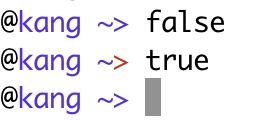

Useful shell prompt
source link: https://solovyov.net/blog/2020/useful-shell-prompt/
Go to the source link to view the article. You can view the picture content, updated content and better typesetting reading experience. If the link is broken, please click the button below to view the snapshot at that time.

Useful shell prompt#
There are only a few apps I use every day and shell — ZSH — is one of the most used. It’s been that way since the beginning of the ’00s and back then I spent a lot of time configuring my prompt to be a good balance between compact/readable and useful. I found that I dislike fancy two-line prompts, information on a right-hand side (because of its awkward behavior), and stuff like that. So the result looks like that:
piranha@rigel ~> █
where █ is a cursor. It shows username, @ to separate it from hostname - or # if this is uid 0 shell, then hostname, and a home-abbreviated path. One of the fancy things is that space before the cursor is Unicode glyph \u00A0 - non-breaking space - which is bound in ZLE to delete everything to the beginning of a line. Unfortunately, this does not work with Terminal.app, so it just sits there waiting for a better time. This setup along with colors had no changes for over a decade.
But a week ago a saw a tweet with an idea to change prompt’s prompt (the > thingie) to a red color when previous command exited with an error status. This motivated me to cleanup and update my prompt to a newer conventions. This is a result:

You can see I removed my username since it really gives me no information, no reason to spend space on that. I also really like white background, but if you don’t, changing colors is easy — I’ll explain how everything works.
Let’s break down it bit by bit. The prompt syntax is a little hard on the eyes - in case if you have ideas on how to write this so next time I won’t have to dig deep into ZSH documentation, I’ll be glad to listen.
p_at='%(!.%F{red}%B#%b%f.@)'
In this case, few things are interesting:
%(x.if-true.if-false)construct (documented here) shows either@if I’m a normal user or a red#if I’m a root.!there means “True if the shell is running with privileges”.- You can clearly see
@after the second dot, but what does%F{red}%B#%b%fmean?%Bmeans “start bold”,%bmeans “end bold”. %F/%fduo is “start/stop color” - it can either accept old-style color numbers (where 1 is red) or color names, which is easier to understand.
p_host='%F{blue}%m%f'
p_path='%F{blue}%~%f'
Those are easy to understand, just refer to documentation — %m is a hostname before the first dot, %~ is a path where $HOME is abbreviated to ~.
p_pr='%(?.%F{blue}.%F{red})x%f'
This is a new part. ? means “True if exit status of the last command was 0”. So if a command exited nicely (with a status code 0), then it’s going to be blue >, in other case it’s going to be red x. Voila! :-)
End result looks like this:
p_at='%(!.%F{red}%B#%b%f.@)'
p_host='%F{blue}%m%f'
p_path='%F{blue}%~%f'
p_pr='%(?.%F{blue}.%F{red})x%f'
PS1="$p_at$p_host $p_path$p_pr "
unset p_at p_host p_path p_pr
You can see I’m unsetting color in every variable and unset those variables — cleaning up after yourself is a valuable habit, especially with a shell. :-)
I’m pretty sure the same could be done for bash (or tclsh, or whatever), but I’m not using it so… If anybody wants to contribute a similar configuration for other shells, I’ll gladly link to a post or add it here.
Oct 2020
Recommend
About Joyk
Aggregate valuable and interesting links.
Joyk means Joy of geeK